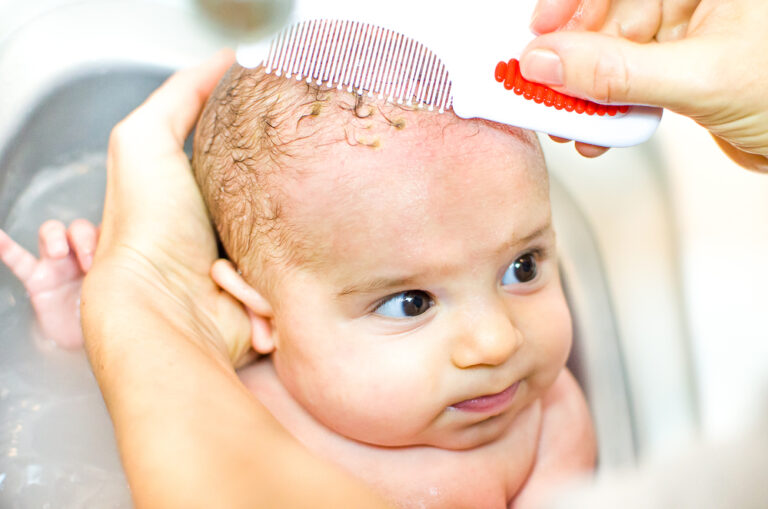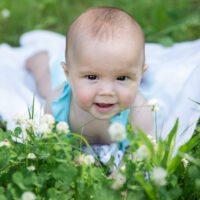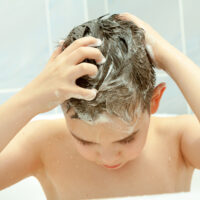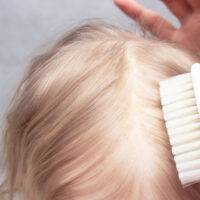Cradle cap (infant seborrheic dermatitis) is scaly, flaky patches on a baby’s scalp and is a common skin issue. It is not dangerous but the buildup of yellow and white scales can leave a crust that might not look or feel nice. 1 in 3 children will get some degree of flaking, redness, scaling, and irritation on their scalp and skin during their first year of life. Some babies can also have seborrheic dermatitis in the diaper area. It can also appear on the face (especially the eyebrows), neck, and trunk.
Always consult with your pediatrician before starting any new products.
Best Tear-Free Cradle Cap Shampoos
Babo Botanicals Sensitive Baby 2-in-1 Shampoo & Wash washes baby’s hair while both preventing cradle cap and soothing dry skin, while Mustela Cradle Cap Foam Shampoo cleanses hair while preventing cradle cap.
Babo Botanicals Moisturizing Baby Shampoo
Babo Botanicals Moisturizing Baby Shampoo helps prevent cradle cap and nourishes dry, sensitive skin. This certified organic and vegan shampoo has been pediatrician, dermatologist, and allergy-tested. Parents praise this shampoo for its great smell, potency, and safety. Although it may seem a bit pricey at first glance, it is very concentrated. A little goes a long way. However, it does contain potential irritants/allergens. It was rated 4 by EWG (Environmental Work Group).
Elizabeth Parker Naturals Baby Shampoo
Elizabeth Parker Naturals Baby Shampoo has the same objectives as the others on this list. It works to fortify the baby’s scalp with nutrients designed to reduce cradle cap. It brings comfort from itching and irritation.
It is tear-free but like all baby shampoos, you should attempt to keep it out of baby’s eyes. The ingredients are organic.
Parents are highly impressed with the gentleness and effectiveness of this shampoo. Most are pleased with how quickly it clears up the symptoms of cradle cap. A money-back guarantee is offered – no questions asked – if you aren’t completely satisfied with your purchase.
It does contain potential irritants/allergens as well as salicylic acid, which is not recommended for all ages. Check with your pediatrician first.
Mustela Foam Shampoo for Newborns
Pediatrician recommended Mustela Foam Shampoo for Newborns is specially formulated to cleanse your baby’s hair and scalp while preventing and treating cradle cap. The tear-free formula – composed of 99% plant-based ingredients, helps protect your newborns’ scalp and prevents cradle cap from recurring. The light, airy foam is hypoallergenic and specially formulated to minimize the risk of allergic reactions. However, there are ingredients that are potential irritants/allergens.
Best Cradle Cap Shampoos for Babies
T is for Tame – Cradle Cap Shampoo is a natural foaming shampoo that has a handy pump, while Hip Peas Cradle Cap Care is also a natural shampoo that is non foaming and comes in regular shampoo bottle.
Hip Peas Cradle Cap Care
Hip Peas Cradle Cap Care is a shampoo designed to combat cradle cap and dry skin in infants. It reduces irritation, flaking, redness, itching and irritation of skin and scalp.
While infants benefit from this shampoo it can be used on children of all ages who experience similar symptoms. Hip Peas Cradle Cap Care contains natural ingredients like olive oil, jojoba oil, sunflower oil, shea butter, lavender oil, wheat germ oil, bergamot oil, and vitamin E. It’s free of side effects and effective over many years for the relief of seborrheic dermatitis and dandruff. All without any chemicals that can cause issues for sensitive skin.
Parents praise this shampoo for how wonderfully it works on the most severe cases of cradle cap.
It does contain potential irritants/allergens.
T is for Tame | Cradle Cap Foaming Shampoo
Protect your baby’s scale with T is for Tame Cradle Cap Foaming Shampoo. It’s ready to reduce scalp redness, eczema, oiliness, and dandruff too with a scientific formula. All of the ingredients are plant-based, non-toxic, hypoallergenic, free of harsh chemicals, and child and pet safe.
Furthermore, some of the ingredients are organic and even ph balanced. It comes with a handy foaming pump dispenser for easy application.
Parents can’t seem to get enough of this natural shampoo. They love its scent-free formula that’s gentle. Try other products in the line to help with other issues for babies’ hair and skin like Cradle Cap Cream.
It does contain potential irritants/allergens as well as salicylic acid, which is not recommended for all ages. Check with your pediatrician first.
Comparing Cradle Cap Shampoos
The table below compares only the recommended products on this page. A low or high Price means it is low or high compared to the other products listed. The Popularity Score reflects how often readers click on and buy the product. The Quality Score is our assessment of the overall performance and satisfaction with the product compared to others in the table.
| Hip Peas Cradle Cap Care | 7.0 | 9.2 | 15.95 |
| Babo Botanicals Moisturizing Baby Shampoo | 9.9 | 9.2 | 14.99 |
| Elizabeth Parker Naturals Baby Shampoo | - | 8.8 | - |
| Mustela Foam Shampoo for Newborns | 7.0 | 9.4 | - |
| T is for Tame | Cradle Cap Foaming Shampoo | 3.9 | 8.0 | - |
Guide to Selecting a Cradle Cap Shampoo
Cradle cap or seborrheic dermatitis is nothing to be feared from a health perspective. It is not symptomatic of allergies or infections and poses no risk to short or long term health. It is also not the result of bad hygiene.
Cradle cap is temporary and is almost entirely gone by 12 months without leaving any marks or scars.
How to Use Cradle Cap Shampoo
- Use one of the shampoos on this list to wash the baby’s hair two or three times per week. This is both a preventive and corrective measure.
- For an added bit of prevention and treatment, brush your baby’s scalp with a soft brush or massage with a washcloth while he’s in the bath. Any baby hair brush will do a great job at gently removing the scaly skin, however most parents recommend the Safety 1st Cradle Cap Brush and Comb. Massage your baby’s scalp with the brush, but be sure not to pick at the scales because this can cause irritation.
- In more severe cases of cradle cap, it may be necessary to wash and brush your baby’s scalp daily to loosen scaly skin.
Things to Keep in Mind
- Shampoo frequently. You may be tempted to wash your baby’s hair less frequently to avoid subjecting them to shampoo. Don’t worry about too much washing. If you use the gentle shampoos mentioned here and wash frequently, continuing to brush, you’ll keep the cradle cap at bay without unduly subjecting baby’s hair and scalp to some of the stronger but harsher ingredients found in other shampoos. Stick to baby hair products that are designed for babies.
- Petroleum jelly is often recommended for cradle cap. However, baby oil is not very helpful or necessary. Using unperfumed baby oil or mineral oil, without a specially formulated shampoo allows scales to build up on the scalp, particularly over the soft spot on the back of the head, or fontanelle.
- Your doctor may also prescribe a cortisone cream or lotion. Cradle cap often improves after the application of these treatments and is less likely to recur if you continue preventive measures. To do this, simply continue with frequent hair washings and use a mild baby shampoo.
FAQ’s about Cradle Cap Shampoos
Many of the ingredients included in these products are controversial, or have limited or no data/research on use for babies. Some ingredients have been linked to health problems. Many products have not been evaluated by the FDA. Since no studies have been conducted with these products on babies there is no absolute certainty that these are 100% safe. Always consult with your pediatrician before starting any products on your baby.
Since the FDA does not regulate cosmetic products, the Environmental Work Group (EWG) has created a database of products. It offers information on the most popular products and ingredients, such as whether the product is an irritant/allergen or linked to organ/reproductive toxicities. It rates products from 1 to 10, with 1 being the least toxic. It is best to stick to products that rate EWG verified, 1 or 2.
What causes cradle cap?
According to Kids Health, the exact cause of cradle cap is unknown. Although, some researchers believe it’s due to an overproduction of skin oil (sebum) in the oil glands and hair follicles. A type of yeast (fungus) called malassezia can grow in the sebum along with bacteria, and this may be another factor in the development of cradle cap.
Seborrhea happens most often in babies and teenagers. In both of these times in a person’s life, hormone levels are high, which also might play a role in the condition.
Certain factors like weather extremes, oily skin, problems with the immune system, stress, and other skin disorders can make it more likely that a child will get cradle cap.
Are there any home remedies for cradle cap?
Yes. Many parents find that coconut oil or extra virgin olive oil works well for treating cradle cap. Simply rub a small amount on your baby’s scalp. Allow it to sit for a few minutes, then massage with a cradle cap brush. After rinsing, wash with a gentle baby shampoo. Do not let the oil sit on your child’s scalp overnight. This can cause the oil glands to become clogged, thus worsening the condition.
Be aware that there are many popular products and home remedies being advertised as the answer to treat cradle cap. Unfortunately, most of these solutions do not work and even the ones that do may contain toxins or ingredients that are too strong for your infant. Some of these include essential oils, undiluted apple cider vinegar, and hydrogen peroxide. While they may not pose health hazards, they can certainly result in increased irritation.
What should I do if the cradle cap is severe and doesn’t clear up with the techniques listed above?
At-home treatment is effective for most cases of cradle cap. If for some reason, it doesn’t work in your case, you may want to consult a healthcare provider to be advised on alternative cream or shampoo products or more advanced treatments for your baby. As a reminder, cradle cap isn’t to be feared from a health perspective but consulting your doctor is advisable if you feel like the condition is irritating baby.
What is the difference between cradle cap and eczema?
Cradle cap happens when the glands of the scalp make too much sebum (oil). This traps the skin flakes that are constantly being shed from the scalp and causes the formation of the yellow scales. It usually does not itch or cause the baby any discomfort. Cradle cap is sometimes confused with eczema. A major difference between these two skin conditions is that the cause of eczema is not exactly known. It can be caused by genetics, as well as a defect in the barrier function of the skin, and a problem with the immune system. It usually causes significant itching. Many different allergens and irritate can trigger eczema.
What is cradle cap?
Like infant acne (20% of infants), cradle cap is a normal condition of infancy (70% of infants) that is neither harmful nor very long-lasting. Unlike the acne, which occurs during the first weeks of life, cradle cap can occur any time during the first year. Cradle cap is recognized as flaky, scaly, or crusty patches on the scalp.
Does cradle cap need to be treated?
In most cases, cradle cap causes no discomfort to the infant, and the condition will resolve on its own. Rare cases can lead to temporary hair loss. Aside from normal cleansing with a gentle shampoo, therefore, treatment is optional. If the condition seems severe or uncomfortable, however, consult your doctor, who may recommend a medicated shampoo, hydrocortisone cream for inflammation, or even an antibiotic or antifungal if an infection is present.
Can cradle cap be prevented?
The cause of cradle cap is not clear. Perhaps it can be discouraged by good hygiene (short bath and shampoo no more than once per day, gentle lubrication of the scalp).
What kind of oil should I use on my baby’s scalp?
There are a number of lotions and oils that one might use. Due to the frequency of peanut allergies, do not use peanut oil. New information about oleic acid has brought into question the use of olive oil over many days or on dry or damaged skin. Coconut and almond oils are favorites of some. Many doctors may recommend baby oil, petroleum jelly, or mineral oil. The most common recommendation is that oils be applied a few minutes before bathtime and then shampooed away in the bath.
Can you pick off cradle cap?
It’s better just to wash the scalp with a cloth or to brush with a small, very soft brush or toothbrush. Picking scales that are not loose may lead to infection.
Does cradle cap cause hair to fall out?
In rare cases, cradle cap may cause some hair loss. The hair should regrow, however, after the condition resolves.
To find a great lotion that can help combat excessive dryness and itching, check out our best baby lotion for dry skin list.











